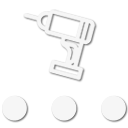Which type of battery doesn't really come into it. Yes, some are supposedly designed to be more for starting and cranking and others for long slow discharge, but the principles of charging remain the same.
I have been doing some research into on board battery charging and have now come to the conclusion that dc-dc chargers are the way forward.
I've run split charge for years in the Mitsubishi, and now the Defender, but having delved more into ways of improving efficiency and maintaining battery condition, I'm of the conclusion that a decent dc-dc charger is a better way of doing it.
I'm considering a
Ctek d250 and, when I get round to fitting solar panel(s) a
Smartpass.
The 5 stage conditioning is so much better for the batteries and helping maintain condition, charge and longevity.
Alternator output counts for a lot. If you're running a standard alternator (usually 60 to 80 amps), then trying to keep up with a larger starting battery and big auxiliary battery or batteries, powering things like fridge, inverter, winch(es) etc... then a bigger, or even dual alternator set up will be needed.










